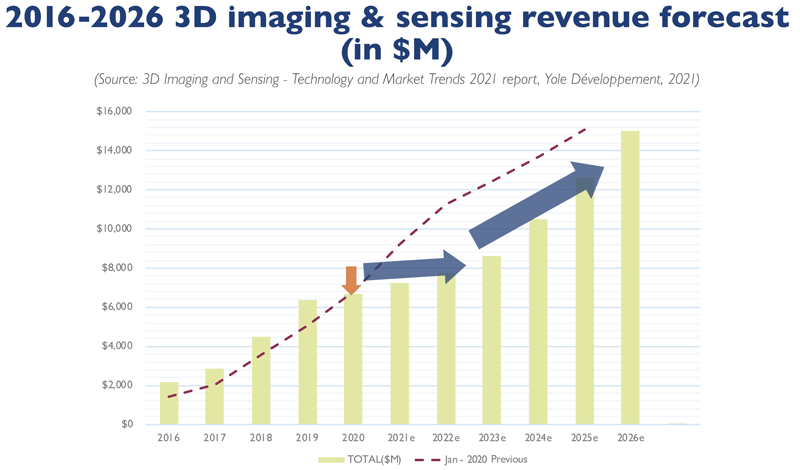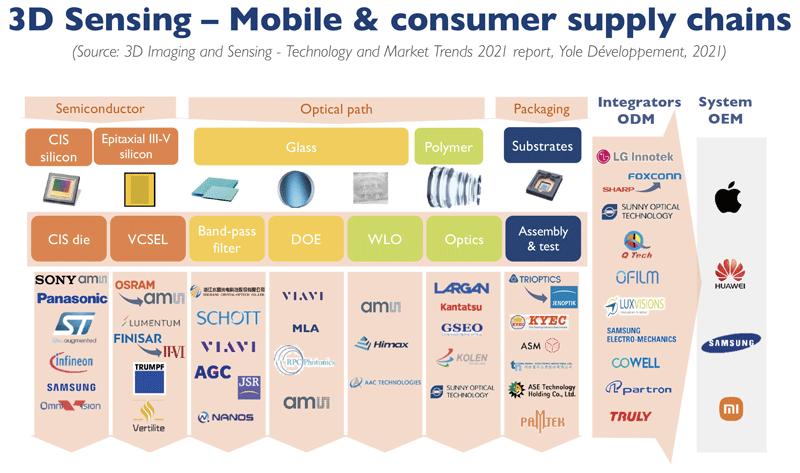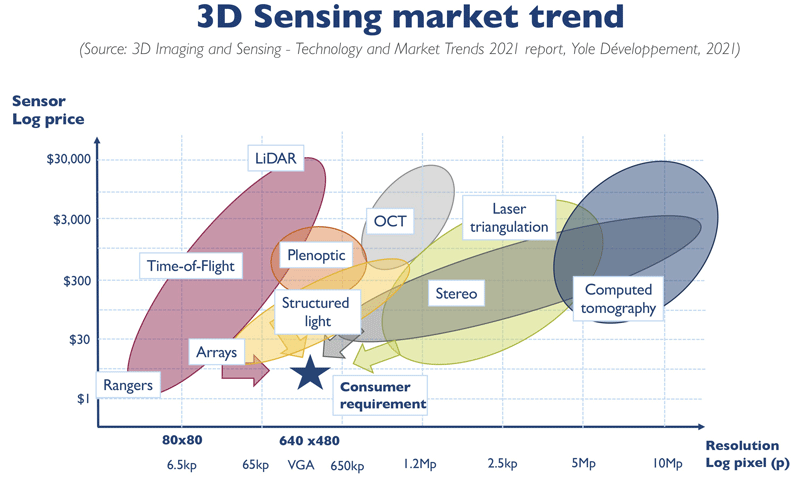News: Markets
12 July 2021
3D imaging and sensing market growing at 14.5% CAGR to $15bn in 2026
The global 3D imaging and sensing market is rising at a compound annual growth rate (CAGR) of 14.5% from $6.8bn in 2020 to $15bn in 2026, reckons market research and strategy consulting firm Yole Développement in its latest annual report ‘3D Imaging and Sensing - Technology and Market Trends 2021’.

Mobile & consumer is the main segment, and will comprise 46% of the total 3D imaging and sensing market in 2026, it is forecasted. This will be followed by the automotive and industrial segments, both at 22%.
Concerning technology trends, the three most common 3D sensing technologies are stereo, structured light and time-of-flight (ToF). Light detection & ranging (LiDAR), when paired with autonomous driving, is a hot technology, but it is still in its infancy, notes Yole. Laser triangulation in machine vision and interferometric (OCT) in medical are well established.
Supply chain
Apple continues to adopt structured light technology in its whole lineup. The firm has also successfully released a 3D rear camera in iPhone 12 Pro. Benefiting greatly from this are the key 3D camera component suppliers, such as STMicroelectronics, Sony, ams, Lumentum and Largan as well as module makers LG Innotek and Sunny Optical. Amongst Apple’s supply chain, STMicroelectronics and Lumentum have benefited the most.
“In mobile markets there is a temporary hiatus in growth of 3D sensing due to the ban of Huawei in the US as well as the fact that the Android camp has abandoned the technology,” says Richard Liu, technology and market analyst in Yole’s Photonics, Sensing & Display division. “The shipment volume of 3D sensing products recorded in 2020 is about 80% of the previous forecast,” he adds. “The gap between previous optimistic forecasts widened as sales leveled off. But under-display camera technology became mature, and there are more low-cost indirect time-of-flight (iToF) sensing solutions. These could drive higher 3D sensing adoption and a return to growth around 2023”.
Apple continues to use front-facing structured light throughout all iPhone series. It also introduced a 3D camera with a direct time-of-flight (dToF) array sensor into the iPhone 12 Pro, a step forward for the 3D sensing market.
As analyzed by Yole in the report, besides mobile phones, 3D sensing technology has a broad reach in the consumer market, including tablets, VR/AR (virtual reality and augmented reality), robot vacuum cleaners, and AIoT (artificial intelligence combined with the Internet of Things). Increased labor costs and manufacturing upgrades are accelerating the development of automation and machine vision, including 3D visual systems, increasing the penetration of 3D vision every year. In 2020 there was a ramp-up of electric vehicles (EVs), which also exploit advanced driving assistance systems (ADAS), the market for which is currently booming. Yole believes that the automotive sector will be a large part of the next wave of 3D sensing adoption.
“3D imaging and sensing technology is an important means to acquire information in the perception of the real world,” notes Pierre Cambou MSc, MBA, principal analyst in the Photonics and Sensing Division. “It provides a basis for detection and recognition as well as for reconstruction of the real geometry of an object and subsequent 3D modeling,” he adds. “It is used in consumer biometry, augmented reality, gaming, autonomous driving and a wide range of applications.”

In mobile 3D sensing, Apple’s supply chain is stable and growing. STMicroelectronics and Lumentum are the most profitable, followed by ams, II-VI and LG Innotek. The Android camp is less healthy. Neither the emitter component suppliers, such as Trumpf and Vertilite, nor the receiver companies, like Omnivision and PMD Technology, have benefited much. The good news is that they are already actively working on 3D sensing in the non-mobile space, such as Vertilite in automotive and PMD in consumer applications.
Within this 3D imaging and sensing ecosystem Sony remains an exception. It is not only the leader of iToF sensor arrays but also the only manufacturer that can provide dToF sensor arrays for consumer applications. It is very competitive. Analysts will not be surprised if it keeps its number-one position no matter how the market changes.
“The 3D sensing market is developing rapidly and offers great opportunities,” says Liu. “In addition to the mobile phone market, automotive ADAS and AR are set to be big 3D sensing applications. In 2020, the rapid growth of electric vehicles with very high intelligence and ADAS brought LiDAR adoption forward. This has attracted a wide range of players, from LiDAR suppliers in traditional industries like Valeo and Velodyne to electronics giants Sony, Huawei and start-ups like Livox and XAOS.”

In all the 3D sensing markets, China is an emerging market. It shows great vitality not only in the 3D back-end application market but also in the 3D front-end supply chain, says Yole. This has been driven by the policy of China cultivating local supply chains in the middle of the US-China trade conflict. Facial payment has been driven by platform vendors AliPay and WeChat, and supported by technology provider Orbbec. In 3D machine vision, Hikrobot and Huaray are starting to compete with the likes of Sick and Lucid. In automotive, the entry of Chinese players has played a decisive role in the price decline of LiDAR, notes Yole.
The fourth Yole Développement and CIOE (China International Optoelectronic Exposition) ‘3D Sensing for Consumer Forum 2021’ is taking place on 2 September, both in Shenzhen, China, and online.
3D imaging and sensing market growing at 20% CAGR to $15bn in 2025
www.i-micronews.com/products/3d-imaging-and-sensing-technology-and-market-trends-2021









